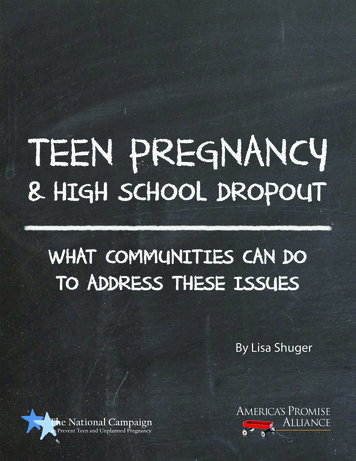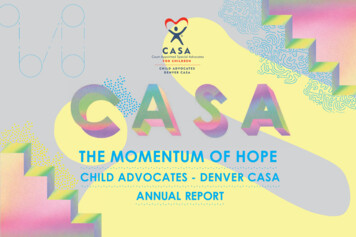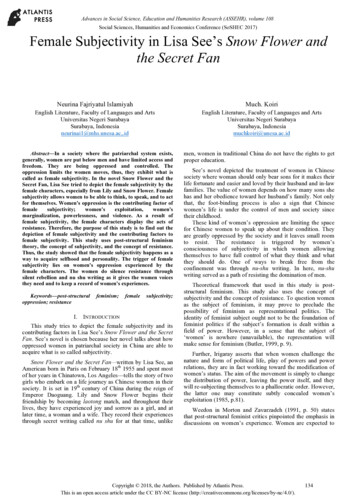
Transcription
By Lisa Shuger
ABOUT THE NATIONAL CAMPAIGNThe National Campaign to Prevent Teen and Unplanned Pregnancy is a nonprofit, nonpartisan initiative supported almost entirely by private donations. Our mission is to promote values, behavior, and policies thatreduce both teen pregnancy and unplanned pregnancy among young adults. By increasing the proportionof children born into welcoming, intact families who are prepared to take on the demanding task of raisingthe next generation, our efforts will improve the well-being of children and strengthen the nation. Please visitwww.TheNationalCampaign.org to find out more.ABOUT AMERICA’S PROMISE ALLIANCEAmerica’s Promise Alliance is the nation’s largest partnership dedicated to improving the lives of children andyouth. We bring together more than 400 national organizations representing nonprofit groups, businesses,communities, educators and policymakers. Through our Grad Nation campaign, we mobilize Americans toend the high school dropout crisis and prepare young people for college and the 21st century workforce.Building on the legacy of our Founding Chairman General Colin Powell, America’s Promise believes the successof young people is grounded in Five Promises: Caring Adults, Safe Places, A Healthy Start, Effective Education,and Opportunities to Help Others. www.americaspromise.org.ACKNOWLEDGEMENTSThe National Campaign to Prevent Teen and Unplanned Pregnancy wishes to thank Ashten Waks for help withresearching this report and Andrea Kane and Nick Halzack for reviewing this document and providing valuablefeedback.Copyright 2012 by The National Campaign to Prevent Teen and Unplanned Pregnancy and America’s PromiseAlliance. All rights reserved.SUGGESTED CITATIONShuger, L. (2012). Teen Pregnancy and High School Dropout: What Communities are Doing to Address These Issues.Washington, DC: The National Campaign to Prevent Teen and Unplanned Pregnancy and America’s PromiseAlliance.
OVERVIEWNearly one-third of teen girls who have dropped out of high school cite early pregnancy or parenthood asa key reason.1 Only 40 percent of teen moms finish high school, and less than two percent of teen mothers(those who have a baby before age 18) finish college by age 30. The high school dropout rate in this countrycontinues to be a crisis; nearly one in four Americans and four in 10 minorities do not complete high schoolwith their class. In addition, the national graduation rate increased by 3.5 percentage points between 2001and 2009 (from 72 percent in 2001 to 75.5 percent in 2009). The number of “dropout factories” (schools withgraduation rates of 60 percent or less) totaled 1,550 in 2010, down from 1,634 in 2009 and a high of 2,007 in2002. The number declined by 84 between 2009 and 2010.2 There are nearly 14,000 school districts in theUnited States; twenty-five persistently low-achieving school districts accounted for one in five of the nation’sdropouts.3,4 A new analysis shows that in 2008 there were a total of 69,809 births to teens who lived in counties or cities where these 25 school districts are located.5Because there is a close connection between teen pregnancy and academic failure and because teen pregnancy affects the educational achievement of teens themselves (as well as that of their children), those concernedabout educating young people should also be concerned with preventing teen pregnancy. Moreover, giventhe increasing demands in schooling that are necessary to compete in the 21st century job market, it is moreimportant than ever for teens to finish high school and attain postsecondary education when possible.6Notwithstanding the association between teen pregnancy and high school dropout, little research exists onthe relationship between these two issues in school districts across the country. The primary focus of thisreport is to highlight innovative ways school systems—particularly persistently low-achieving school districtswith high teen birth rates—and public agencies and community-based organizations that oversee teen pregnancy prevention programs are working together with the common goal of helping students avoid too-earlypregnancy and parenthood and complete their high school education. The report also provides examples ofstrategies for connecting efforts to prevent teen pregnancy and improve educational attainment that education, health, and community leaders around the country might find helpful as they work to reduce teen pregnancy and improve graduation rates.TEEN PREGNANCY AND HIGH SCHOOL DROPOUT IN THE UNITED STATESTeen pregnancy has declined 42 percent since its peak in 1990 and the U.S. teen birth rate is now at an all-timelow. Despite this impressive progress, however, it is still the case that nearly three in 10 girls in this countrywill become pregnant before the age of 20. The United States has the highest rate of teen pregnancies in thedeveloped world—approximately 750,000 pregnancies to teens each year.7 At a time when the U.S. needsto become more competitive in the global economy, our teen pregnancy rates are still much higher than ourtrading partners and competitors.The National Campaign to Prevent Teen and Uplanned Pregnancy www.TheNationalCampaign.org1America’s Promise Alliance www.AmericasPromise.org
It is also the case that one in four U.S. public school students drop out of high school before graduation andAmerica continues to face a dropout epidemic. Although graduation rates have increased slightly to 75.5percent in recent years, achieving a 90 percent nationwide high school graduation rate by 2020 continues tobe a challenge.Research indicates that fully 30 percent of teen girls who have dropped out of high school cite pregnancy orparenthood as a key reason. Rates are even higher for African American and Latino girls—38 percent and 36percent respectively.8 A 2006 report by Civic Enterprises for the Bill and Melinda Gates Foundation found that26 percent of students said they dropped out when they became a parent.9 Although many teen parents whoare unable to complete high school pursue a GED, obtaining a GED is also a challenge. Almost one-half offormer teen mothers who completed a GED did so after the age of 18.10 Moreover, one in three (34%) youngwomen who had been teen mothers, earned neither a diploma nor a GED, compared with only 6 percent ofyoung women who had not had a teen birth.Both teen parents who drop out of high school and children of teen parents suffer serious educational challenges. Too-early pregnancy and parenthood not only makes it more difficult to complete education, career,and other life goals for teen parents, but it also affects the future prospects of their children. Research showsthat children of teen mothers start school at a disadvantage and fare worse than those born to older parents.For example, children born to teen mothers begin kindergarten with lower levels of school readiness (including lower math and reading scores, language and communication skills, social skills, and physical and socialwell-being), compared to children born to women in their twenties.11The impact of students leaving high school also has devastating economic consequences. Over the courseof a lifetime, a college graduate will earn, on average, 1 million more than a high school dropout. Droppingout is literally a million-dollar mistake. According to the Alliance for Excellent Education, it is estimated thatover the course of his or her lifetime, a single high school dropout costs the nation approximately 260,000 inlost earnings, taxes, and productivity.12 Put another way, if students who dropped out of the Class of 2011 hadgraduated from high school, the nation’s economy would likely benefit from nearly 154 billion in additionalincome over the course of their lifetimes.13 In addition, teen childbearing in the United States cost taxpayers(federal, state, and local) at least 10.9 billion in 2008.14While improving educational attainment is a widespread goal, graduation rates vary greatly among schoolsand there has been particularly intense attention to the lowest performing schools and school districts. Twenty-five persistently low-achieving school districts account for 20 percent of all high school dropouts in theUnited States. In 2008, these school districts saw a combined total of 225,374 non-graduates exit their schoolsystem. A new analysis by The National Campaign shows that in 2008, there were a total of 69,809 births toteens who lived in counties or cites where these 25 persistently low-achieving school districts are located (seeTable 1). Furthermore, births to teens in these 25 school districts account for 16 percent of teen births in theUnited States, which underscores the close association between teen pregnancy and high school dropout.15In short, the connection between too-early pregnancy and parenthood and educational attainment is strong.Consequently, it is critical that policymakers, state and local officials, advocates, local school superintendents,business leaders, philanthropists, and others interested in the prospects for this generation of young peopleand the next are able to collaborate and develop strategies that address the risk for dropping out of school asa result of teen pregnancy and parenthood.The National Campaign to Prevent Teen and Uplanned Pregnancy www.TheNationalCampaign.org2America’s Promise Alliance www.AmericasPromise.org
Table 1: Number of Drop-Outs and Teen Births in Twenty-Five Persistently Low-Achieving SchoolDistricts in the U.S.Total No.of Students16DistrictGraduation Rate17Projected No.of Non-Graduates18Total No. of TeenBirths in City/County19,20Albuquerque Public Schools95,96555.4%3,9631,178Broward Co. School g Schools131,17661.2%4,7871,332City of Chicago School District 299407,51070.2%10,4695,801†Clark County School District309,05143.1%16,1143,134Dallas ISD157,80448.7%6,9903,529†Dekalb County100,27349.6%4,8801,112Detroit City School District107,87433.4%8,0392,418†Duval County School District124,74049.9%5,5501,479Gwinnett County155,61860.9%5,3661,011Hawaii Department of Education179,89765.8%5,5231,640Hillsborough County School District193,18063.8%5,8672,042Houston ISD199,53453.5%7,8526,459†Kern Union High School District37,34159.8%4,3132,304Los Angeles Unified School District693,68048.7%35,5686,292†Memphis City School District115,34260.1%4,1092,131†Miami-Dade County School District348,12862.1%11,3102,957Milwaukee School District86,81950.9%4,3151,857†New York City Public Schools989,94157.3%39,6698,384†Orange County School District174,14264.5%5,3961,674Palm Beach Co. School District170,88367.1%5,0001,358Philadelphia City School District172,70445.8%9,3043,523†Phoenix Union High School District26,48345.2%4,2093,810†Prince George’s Co. Public Schools129,75267.1%4,2601,200San Diego Unified School District131,57758.1%5,0441,531†School District†Figure represents the number of teen births in the cityKEY DATA Parenthood is a leading cause of school dropout among teen girls. Thirty percent of all teen girls whohave dropped out of high school cite pregnancy or parenthood as a key reason, and the rate is higher forminority students: 36 percent of Hispanic girls and 38 percent of African American girls cite pregnancy orparenthood as a reason they dropped out.21 One in three (34%) young women who had been teen mothers earned neither a diploma nor a GED, compared with only six percent of young women who had not had a teen birth.22 Less than two percent of young teen mothers (those who have a baby before age 18) attain a collegedegree by age 30.23The National Campaign to Prevent Teen and Uplanned Pregnancy www.TheNationalCampaign.org3America’s Promise Alliance www.AmericasPromise.org
In 2008, the 25 persistently low-achieving school districts saw a combined total of 225,374 non-graduatesexit their school systems.24 These 25 persistently low-achieving school districts account for 20% of all high school dropouts in theUnited States.25 In 2008, there were a total of 69,809 births to teens who lived in counties or cities where these 25 persistently low-achieving school districts are located.26,27 Births to teens in the 25 persistently low-achieving school districts account for 16% of teen births in theUnited States.28,29 Over the course of a lifetime, a college graduate will earn, on average, 1 million more than a high schooldropout. Over the course of his or her lifetime, a single high school dropout costs the nation approximately 260,000 in lost earnings, taxes, and productivity.30 If students who dropped out of the Class of 2011 had graduated from high school, the nation’s economywould likely benefit from nearly 154 billion in additional income over the course of their lifetimes.31 Ninety percent of adults believe reducing teen pregnancy is a very effective way to reduce the high schooldropout rate and improve academic achievement.32 Seventy-three percent of adults want teens to receive more information about both birth control andabstinence rather than either/or (11% wants teens to get more information about birth control; 14% wantteens to get more information about abstinence).33HOW SCHOOLS AND COMMUNITIES IN THE UNITED STATES AREADDRESSING TEEN PREGNANCY AND DROPOUT PREVENTION: OVERVIEWMany struggling school districts have shown both high dropout rates and high numbers of teen births. Inits national report, Diplomas Count 2011, Education Week and Editorial Projects in Education (EPE) ResearchCenter identify the 25 persistently lowest-achieving school districts in the United States—those that accountfor one in five of the nation’s dropouts. Births to teen students in these school districts account for 16 percentof teen births in the United States.34,35A number of these school districts, state departments of education, and community-based organizationsacross the country have recognized the clear link between teen pregnancy and school dropout, and in response have initiated efforts to tackle these two high priority issues. In some instances school leaders are collaborating with state and local government agencies and community-based organizations receiving federallyfunded teen pregnancy prevention grants, such as the U.S. Department of Health and Human Services (HHS)Office of Adolescent Health’s (OAH) Evidence-based Teenage Pregnancy Prevention (TPP) Program, whichprovides competitive grants to a broad range of organizations and agencies.36 There are a few TPP grants going directly to school districts, such as Chicago Public Schools in Illinois and Iredell-Statesville Schools in NorthCarolina. Some OAH funds go directly to school-based grantees—public or private organizations who are collaborating with schools to serve students in the school setting. Grantees are using a variety of evidence-basedmodels chosen to meet the needs of their communities and the age of the students they are serving. Somegrantees are using programs that teach both abstinence and contraception, while others are using programsthat emphasize abstinence. Many programs have a strong focus on youth development, goal setting, andmaking responsible decisions.The National Campaign to Prevent Teen and Uplanned Pregnancy www.TheNationalCampaign.org4America’s Promise Alliance www.AmericasPromise.org
There is also federal funding available through the HHS’ Administration of Children, Youth, and Families’ (ACYF)Personal Responsibility Education Program (PREP), which provides formula grants to states, tribes, and territories for evidence-based programs to educate adolescents about pregnancy prevention, sexually transmittedinfections (STIs), and other adulthood preparation topics. Within PREP there are also Personal ResponsibilityEducation Innovative Strategies (PREIS)—competitive grants to public and private entities to test innovativestrategies to reduce teen pregnancy. ACYF also administers Abstinence Education grants to states. In somestates, the PREP and Abstinence education grants are subcontracted to local schools or school districts, or toother agencies that offer programs in schools.The Centers for Disease Control and Prevention (CDC) also provides grants to nine state and local organizations to advance community-wide strategies to reduce teen pregnancy. Schools are closely involved in mostof these projects. In addition, the Pregnancy Assistance Fund, administered by OAH, provides grants to statesand tribes to provide pregnant and parenting teens and women with a network of support services to helpthem complete high school or postsecondary degrees through access to health care, child care, family housing, and other critical supports, including information about how to prevent subsequent unplanned pregnancies. Funding through this program supports services at high schools, institutions of higher education, andcommunity service centers.In order to find out more about these federally-funded programs and the grants to various states and communities, visit the following federal websites: http://www.hhs.gov/ash/oah/oah-initiatives/tpp; tm; and ams/tpp.htm.HOW SCHOOLS AND COMMUNITIES IN THE UNITED STATES AREADDRESSING TEEN PREGNANCY AND DROPOUT PREVENTION: EXAMPLESThe National Campaign has identified a number of interesting examples of how the education and healthsectors in communities with high teen birth and dropout rates are working together to improve graduationrates by addressing teen pregnancy prevention. We focused primarily on places using the federal teen pregnancy prevention grants described above, and conducted interviews with officials involved in these projects.Interviews focused on the nature and structure of teen pregnancy prevention programs, ways grantees haveengaged school administrators, parents, and others in the community, and successful strategies for makingthe case for the relationship between teen pregnancy and school completion. This is by no means an exhaustive list and is not intended to serve as a complete representation of the activities and programs operating inschools throughout the United States. However, it highlights some “bright spots” that could be replicated ormodified in other school districts and communities around the country.Morris Heights Health Center and New York Public Schools—Bronx, NYChanging the Odds Teen Pregnancy Prevention Program, a new youth development program offered throughthe Morris Heights Health Center, is currently operating in three middle and nine high schools in the Bronxarea of New York City Public Schools. Based on the Teen Outreach Program (TOP )—a program which hasbeen shown to decrease teen pregnancy and improve educational outcomes—Changing the Odds offers students lessons in sexual health, relationships, values, communication and assertiveness, goal-setting, and decision making. In addition to the lessons taught during school hours and in after school programs, Changing theThe National Campaign to Prevent Teen and Uplanned Pregnancy www.TheNationalCampaign.org5America’s Promise Alliance www.AmericasPromise.org
Odds provides students with an opportunity to establish a community service project that will benefit theircommunity. Through this community service project, students are expected to practice their communicationskills, discover their own strengths, and recognize their power to affect change.As New York City struggles with both high numbers of teen births and dropouts—approximately 8,384 and39,669, respectively—the staff at Morris Heights Health Center hopes to integrate their Changing the Oddsprogram into the district-wide sex education curriculum. The hope is that the program will both help prevent teen pregnancy and improve educational achievement. To achieve this, the Changing the Odds programrecently developed and submitted pre- and post-test survey measures to the New York City Department ofEducation’s Institutional Review Board (IRB). Once approved, this preliminary evaluation will be administeredto students beginning the Changing the Odds program and then repeated at the end of the academic year inwhich the program was completed. The survey will include questions regarding students’ knowledge of sexual and reproductive health as well as questions that assess school performance and dropping out (e.g. “Haveyou failed a class this semester?” or “How many class periods have you missed during this academic year?”). Byincluding these school achievement and completion indicators in the evaluation of their pregnancy prevention program, the staff at Changing the Odds are taking key steps in underscoring the link between pregnancyprevention and school completion.The Prevention Research Center and Harris County Schools—TexasThe Prevention Research Center (PRC) of the University of Texas Health Science Center received an OAH grantto deliver It’s Your Game: Keep it Real!—a theory-based pregnancy, HIV, and sexually transmitted infectionprevention curriculum developed by researchers at the Center—to 10 school districts in the Houston metropolitan area. This program focuses on decisionmaking to help adolescent students set personalbehavioral limits, recognize threats, and use refusalskills to defend their set limits. The overall goal of“Each year, we at the UTPRC host a three to fourthis project is to promote sexual abstinence, reduceday training course on adolescent sexual health,risky sexual behavior, and prevent teen pregnancywhich is open to Harris County community memamong youth in 84 middle schools throughoutbers as well as to educators and practitionersHarris County. The curriculum’s lessons on sexualfrom across the state of Texas. During this trainand reproductive health simultaneously target theing course, we explain the connection betweenarea’s high dropout rate (46%) and the large proteen pregnancy and problems such as high schoolportion of the city’s births that are to teen mothersdropout, school absenteeism, and poverty in order(16%). The program has a goal of reaching at leastto reframe participants’ thinking about adolescent30,000 middle school students each year.sexuality. While school and district administratorsmay not have considered the link between theseThe PRC has made extensive efforts to educate parissues prior to the training course, we are pleasedents, school leaders, and teachers about the importo see them learning about this important linktance of implementing evidence-based programthrough our course each year.”ming and how this can affect school completionlevels. As part of these efforts, the PRC has become- Dr. Susan Tortoleroinvolved with School Health Advisory Councils conDirector, Center for Health Promotiontained within each school district. These Councilsand Prevention Research, Universityare comprised partially of parents and teachersof Texas Prevention Research Centerand are intended to provide advice on coordinat-HARRIS COUNTY, TEXASThe National Campaign to Prevent Teen and Uplanned Pregnancy www.TheNationalCampaign.org6America’s Promise Alliance www.AmericasPromise.org
ing school health programming. To ensure that parents and teachers are educated about the effectiveness ofprograms—a concern among many parents—of evidence-based sex education programs, trainers from thePRC attend School Health Advisory Council meetings in every school district to talk about the importance ofsex education and to build support for It’s Your Game: Keep it Real!. In addition, the PRC administered a survey about sex education to assess attitudes of parents whose children are enrolled in Harris County public schools. Specifically, this survey asked parents a number of questions about whether sex education should be taught in schools, what should be taught, and who shouldhave authority over the content taught in public school sex education programs More than two-thirds of parents believe sex education programs should include information about bothabstinence and contraception beginning as early as middle school. The survey also indicated that parents (84%), health professionals (63%), and teachers (52%) should haveprimary responsibility in deciding how sex education is delivered in schools.Given the strong survey findings in support of school-based sex education, the PRC has been able to movebeyond claims that parents are opposed to such programming and to continue with their efforts to educateparents about the advantages of their curriculum.To further educate parents, teachers, and district leaders and to communicate widely about the relevance oftheir programming, the PRC has created a special section on their website (www.utprc.org) that focuses on thelink between teen pregnancy/births and school dropouts. The website provides maps of both teen birth ratesand dropout rates for each district with the hopes that this will help community leaders better understand theconnection between these two critical issues.The PRC has also provided training to help local health departments understand the connection between teenpregnancy and the dropout crisis in their communities, and to learn more about evidence-based programs.Recently, Midland, TX, adopted the It’s Your Game: Keep it Real! program after sending several of their healtheducators to this multi-day training. Efforts are also underway to take this initiative to school districts in otherstates.Health Research Association and Los Angeles Unified School District—CaliforniaThe Health Research Association of the University of Southern California recently partnered with the LosAngeles (LA) County Health Department and LA Unified School District (LAUSD) to administer It’s Your Game:Keep it Real!. With sites in 16 middle and seven high schools throughout LAUSD, the Health Research Association anticipates that they will serve nearly 15,000 school-aged youth per year. The program is taught in 7th,8th, and 9th grade health and science courses. District leaders agree that with over 50 percent of the LAUSDstudents expected to fail to graduate from high school each year and given that nearly 10% of births in LosAngeles are to females below the age of 20, initiating this sex education program in middle and early highschool is especially important.For almost 10 years leading up to their It’s Your Game: Keep it Real! collaboration, the LA County Health Department and LAUSD partnered to administer Project Connect, another STI and teen pregnancy prevention program developed with a grant from CDC. As a result of this long-standing relationship, the school district hasbeen involved in the It’s Your Game: Keep it Real! project from the beginning. Specifically, they worked closelyThe National Campaign to Prevent Teen and Uplanned Pregnancy www.TheNationalCampaign.org7America’s Promise Alliance www.AmericasPromise.org
with Health Research Association to identify the most pressing needs of their students and then to incorporate these needs into a proposal for OAH funding—a proposal that was approved at the district-level beforeit could even be submitted to OAH. Since the program’s inception, Health Research Association has continued to work jointly with the school district, by maintaining an open dialogue and feedback system with thedistrict’s Department of Health and Human Services, Assistant Superintendent for Health and Human Services,Medical Director, Director of Nursing, Health Education Coordinator, and four local-level nurses. The direct collaboration between Health Research Association and LAUSD has allowed for two important outcomes: 1) thedistrict acts as a back-up for Health Research Association in cases where they need additional support or assistance in a particular school site; and 2) Health Research Association is able to focus on the critical link betweenteen pregnancy and school completion at times when the large school district must channel its efforts towardother high priority issues. Overall, coordination with administrators and staff in LAUSD‘s Department of Healthand Human Services has played a key role in Health Research Association’s ability to use the It’s Your Game:Keep it Real! curriculum to effectively address the district’s high rates of teen births and school dropouts.In addition to their successful relationships with key leaders in LAUSD, Health Research Association has alsogarnered additional support for their teen pregnancy prevention program through interactions with districtparents. To ensure that they—and their school sites—would not face resistance from parents whose childrenwere enrolled in the program, Health Research Association administered a number of parent surveys to assess responses to the new curriculum. Based on these surveys, Health Research Association determined thatparents were generally supportive of the sex education curriculum in their children’s schools as long as theywere informed about the details of the curriculum and given the opportunity to opt out of the program if desired. With this information, the agency has been able to reassure district administrators and teachers who areconcerned with parent opposition about the broad support for the program and, ultimately, to reinforce theirprominent place in LAUSD’s teen pregnancy prevention efforts.Girls Incorporated of Memphis and Memphis City Schools—TennesseeFor over 60 years, Girls Inc. of Memphis has been working to promote confidence and self-sufficiency in girlsage 6-18. With 2,131 teen births per year in Memphis, Girls Inc. of Memphis plays a critical role in promotingsexual health and reducing teen pregnancy among students enrolled in Memphis public schools. Throughboth in-school and afterschool programming, Girls Inc. of Memphis offers a number of activities to buildgirls’ capacity for college preparedness, responsible adulthood, economic independence, and personal fulfillment—all skills and qualities directly related to prevent
of a lifetime, a college graduate will earn, on average, 1 million more than a high school dropout. Dropping out is literally a million-dollar mistake. According to the Alliance for Excellent Education, it is estimated that over the course of his or her lifetime, a single high school dropout costs the nation approximately 260,000 in










